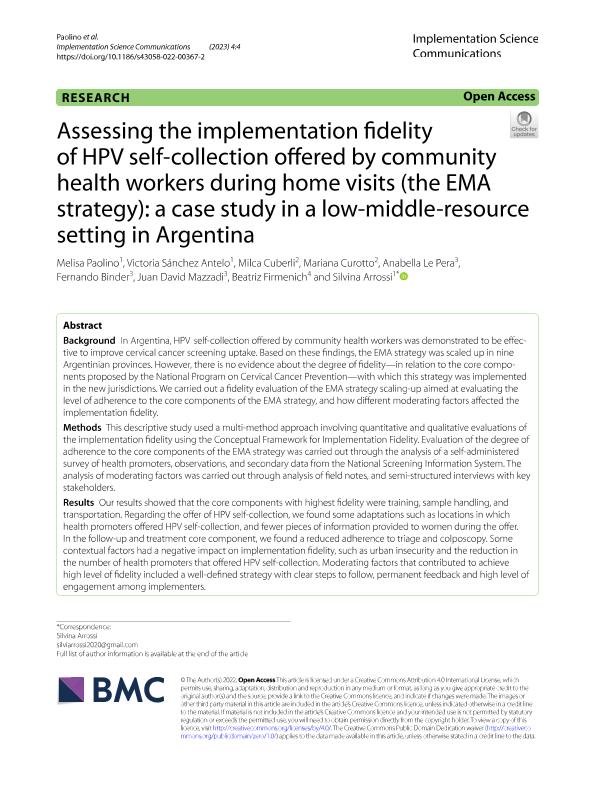Mostrar el registro sencillo del ítem
dc.contributor.author
Paolino, Melisa Delia

dc.contributor.author
Sánchez Antelo, Victoria Inés María

dc.contributor.author
Cuberli Alonso, Milca Beatriz

dc.contributor.author
Ferraresi Curotto, Mariana

dc.contributor.author
Le Pera, Anabella Hebe

dc.contributor.author
Binder, Fernando

dc.contributor.author
Mazzadi, Juan David
dc.contributor.author
Firmenich, Beatriz Marcela

dc.contributor.author
Arrossi, Silvina

dc.date.available
2023-11-30T18:48:12Z
dc.date.issued
2023-01
dc.identifier.citation
Paolino, Melisa Delia; Sánchez Antelo, Victoria Inés María; Cuberli Alonso, Milca Beatriz; Ferraresi Curotto, Mariana; Le Pera, Anabella Hebe; et al.; Assessing the implementation fidelity of HPV self-collection offered by community health workers during home visits (the EMA strategy): a case study in a low-middle-resource setting in Argentina; BioMed Central; Implementation Science Communications; 4; 1; 1-2023; 1-19
dc.identifier.uri
http://hdl.handle.net/11336/218932
dc.description.abstract
Background: In Argentina, HPV self-collection offered by community health workers was demonstrated to be effective to improve cervical cancer screening uptake. Based on these findings, the EMA strategy was scaled up in nine Argentinian provinces. However, there is no evidence about the degree of fidelity—in relation to the core components proposed by the National Program on Cervical Cancer Prevention—with which this strategy was implemented in the new jurisdictions. We carried out a fidelity evaluation of the EMA strategy scaling-up aimed at evaluating the level of adherence to the core components of the EMA strategy, and how different moderating factors affected the implementation fidelity. Methods: This descriptive study used a multi-method approach involving quantitative and qualitative evaluations of the implementation fidelity using the Conceptual Framework for Implementation Fidelity. Evaluation of the degree of adherence to the core components of the EMA strategy was carried out through the analysis of a self-administered survey of health promoters, observations, and secondary data from the National Screening Information System. The analysis of moderating factors was carried out through analysis of field notes, and semi-structured interviews with key stakeholders. Results: Our results showed that the core components with highest fidelity were training, sample handling, and transportation. Regarding the offer of HPV self-collection, we found some adaptations such as locations in which health promoters offered HPV self-collection, and fewer pieces of information provided to women during the offer. In the follow-up and treatment core component, we found a reduced adherence to triage and colposcopy. Some contextual factors had a negative impact on implementation fidelity, such as urban insecurity and the reduction in the number of health promoters that offered HPV self-collection. Moderating factors that contributed to achieve high level of fidelity included a well-defined strategy with clear steps to follow, permanent feedback and high level of engagement among implementers. Conclusions: Our study shows how the analysis of fidelity and adaptations of HPV self-collection in real-world contexts are key to measure and maximize its effectiveness in low-middle-income settings.
dc.format
application/pdf
dc.language.iso
eng
dc.publisher
BioMed Central

dc.rights
info:eu-repo/semantics/openAccess
dc.rights.uri
https://creativecommons.org/licenses/by/2.5/ar/
dc.subject
ARGENTINA
dc.subject
HPV SELF-COLLECTION TEST
dc.subject
IMPLEMENTATION FIDELITY
dc.subject
CERVICAL CANCER PREVENTION
dc.subject.classification
Políticas y Servicios de Salud

dc.subject.classification
Ciencias de la Salud

dc.subject.classification
CIENCIAS MÉDICAS Y DE LA SALUD

dc.title
Assessing the implementation fidelity of HPV self-collection offered by community health workers during home visits (the EMA strategy): a case study in a low-middle-resource setting in Argentina
dc.type
info:eu-repo/semantics/article
dc.type
info:ar-repo/semantics/artículo
dc.type
info:eu-repo/semantics/publishedVersion
dc.date.updated
2023-11-29T13:28:15Z
dc.identifier.eissn
2662-2211
dc.journal.volume
4
dc.journal.number
1
dc.journal.pagination
1-19
dc.journal.pais
Reino Unido

dc.description.fil
Fil: Paolino, Melisa Delia. Consejo Nacional de Investigaciones Científicas y Técnicas; Argentina. Centro de Estudios de Estado y Sociedad; Argentina
dc.description.fil
Fil: Sánchez Antelo, Victoria Inés María. Consejo Nacional de Investigaciones Científicas y Técnicas; Argentina. Centro de Estudios de Estado y Sociedad; Argentina
dc.description.fil
Fil: Cuberli Alonso, Milca Beatriz. Consejo Nacional de Investigaciones Científicas y Técnicas; Argentina. Instituto Nacional del Cáncer; Argentina
dc.description.fil
Fil: Ferraresi Curotto, Mariana. Instituto Nacional del Cáncer; Argentina
dc.description.fil
Fil: Le Pera, Anabella Hebe. Consejo Nacional de Investigaciones Científicas y Técnicas; Argentina. Centro de Estudios de Estado y Sociedad; Argentina
dc.description.fil
Fil: Binder, Fernando. Centro de Estudios de Estado y Sociedad; Argentina
dc.description.fil
Fil: Mazzadi, Juan David. Centro de Estudios de Estado y Sociedad; Argentina
dc.description.fil
Fil: Firmenich, Beatriz Marcela. Municipalidad de la Matanza (buenos Aires). Secretaria de Salud Publica.; Argentina
dc.description.fil
Fil: Arrossi, Silvina. Consejo Nacional de Investigaciones Científicas y Técnicas; Argentina. Centro de Estudios de Estado y Sociedad; Argentina
dc.journal.title
Implementation Science Communications
dc.relation.alternativeid
info:eu-repo/semantics/altIdentifier/url/https://implementationsciencecomms.biomedcentral.com/articles/10.1186/s43058-022-00367-2
dc.relation.alternativeid
info:eu-repo/semantics/altIdentifier/doi/http://dx.doi.org/10.1186/s43058-022-00367-2
Archivos asociados
